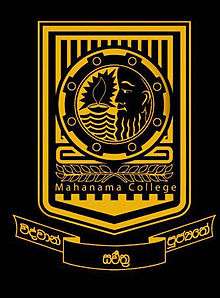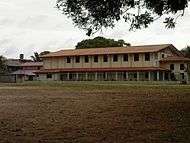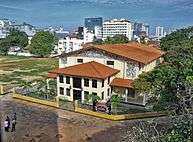Mahanama College
| Mahanama College මහානාම විද්යාලය | |
|---|---|
 | |
| Location | |
|
R. A. D. Mel Mawatha Colombo 03 Sri Lanka | |
| Coordinates | 6°54′22″N 79°51′15″E / 6.90611°N 79.85417°ECoordinates: 6°54′22″N 79°51′15″E / 6.90611°N 79.85417°E |
| Information | |
| Type | National |
| Motto |
විද්වාන් සර්වත්ර පූජ්යතේ (උගතා සැමවිට පැසසුම් ලබයි) Vidvan Sarvathra Poojyate (Scholar will always be reputed) |
| Established | 1954 |
| Founder | Ven. Vahalle Dhammananda thero |
| Principal |
Col. L. M. D Dharmasena (2016–present) |
| Head Prefect | Senal Jayawardana |
| Grades | 1 to 13 |
| Gender | Boys |
| Enrollment | 5000 |
| Colour(s) |
Gold,Silver & Black |
| Song | සිරි ලක වොරදන |
| Affiliation | Buddhist |
| Website | Official Website |
Mahanama College is a Sinhala, Buddhist boys school in Colombo, Sri Lanka which was established in 1954. As a public, national school, it is controlled by the central government, as opposed to a provincial council. It provides both primary and secondary education.
College
Location
Mahanama College is situated in Kollupitiya. College's main entrance is located at R. A. D. Mel Mawatha, Colombo 3 while the south premise is situated right next to C.M.S. Ladies' College, Colombo 7.
History
The institution was founded in 1954 by W.A.K. Gunawardana in Sri Wardanarama, Colombo, with just five students in the class. In 1958, the school was registered as a government-assisted junior school. The number of students gradually increased to 163 with four staff members and, on January 1, 1960, J.D.A. Jayakodi was appointed as the first principal of the school. By 1969, there were 14 staff members and 373 students.
With the rapid increase in student enrollment, the school moved to a nearby location, Valukarama. Primary classes were held in a nearby building, Thurstan College. In 1974, during T. N. Silva's time as principal, the junior school at Thurstan College moved to its present location, Mahanama College. In 1975, 130 students sat for the national General Certificate of Education, and 107 students passed the exam. The government donated 7 acres (28,000 m2) of land as the school expanded. By 1976, the site contained several two-story buildings.
During the early 1970s, principle N.E. Fernando, made improvements to the school's facilities, including the construction of a dental unit and additional classrooms, as well as the first two-story building. Principal K.N.P. de Silva retired on 5 February 1986, and was succeeded by D.G. Sumanasekera. Sumanasekera was the first SLEAS Class-1 principal to head Mahanama. During his four years in office, he laid the foundation for the present school.
K.K. Rathnadasa became principal in 1990 and, during his time at the college, several three-story buildings were constructed, a computer section was established, and a children's park was created. The annual carnival 'Foot-Loose' was also organized during his tenure.
In 1999, G. Liyanage became principal. He added a three-story building with an art gallery to the existing campus. During his tenure, the school laboratories and computer sections were improved and buildings renovated. The Battle of the Golds also known as "Big Match" between Mahanama College and its friendly rival D. S. Senanayake College, Colombo, was inaugurated.[1]
Administration and Education


As it is a national school, college is funded by the Ministry of Education. Ministry appoints principal, the head of the administration. Principal is assisted by Vice principals and academic staff. Like other Sri Lankan colleges the school is divided into three sections named primary,middle and upper school. Each section under its own sectional head who controls the specific sector of the school. School also appointed prefects to maintain the discipline. Prefects are pupils who have been given limited authority over other pupils in the school, similar to the authority given to a hall monitor or safety patrol member.
Mahanama college only consists of Buddhist and Sinhala students. Sinhala is the official language used in the school. However students can choose Sinhala or English medium to do their higher educations.
Prefectorial system
Like other national schools, in addition to the teachers, a selected group of senior boys are entitled to maintain school discipline. Boys who belong to three categories of prefects, are entitled to wear a badge assigned to that specific prefectorial group.
- Head Prefect: the most senior prefect, who is the head of Prefects guild. Selected based on academics, sports and extra-curricular achievements, he is appointed on a probationary basis after completing the final exams at school (GCE Advanced Level). Head Prefect has the authority over all prefects of the college.
- Stewards: selected from students in grade 12, assist the senior prefects to exercise discipline in senior students.
- Junior Prefects: selected from students in grade 9 (grade 8, until 1998), their disciplinary powers are limited to the juniors.
Principals
- Rev. Vahalle Dhammananda (1954–1960)
- J.D.A. Jayakody (1960–1968)
- N.E. Fernando (1968–1974)
- T.S. Silva (1974–1976)
- K.N. P. de Silva (1976–1986)
- D.G. Sumanasekara (1986–1990)
- K.K. Ratnadasa (1990–1999)
- G. Liyanage (1999–2003)
- W.H. Premalal Kumarasiri (2003–2012)
- U.M. Prasanna Upashantha (2013–2016)
- L.M.D Dharmasena (2016–present)
Extra curricular activities
School houses
The students are divided among four houses. The house names are derived from Sanskrit language. Houses are led by House Captains, competing in all major games to win the inter-house games and house colours are awarded winners. Each has their own specific colour code.
| House | Colour Code | Meaning |
|---|---|---|
| Muditha | Means joy. It is especially sympathetic or vicarious joy, the pleasure that comes from delighting in other people's well-being. | |
| Upekha | The Buddhist concept of equanimity. | |
| Karuna | The Buddhist concept of compassion. | |
| Mettha | Benevolence, friendliness, amity, friendship, good will, kindness. | |
A student is placed in one of the above the houses by dividing their index number (which is assigned to each student when the student is registered at the college) by four. The remainder after the division describes their respective house as shown below:
- 0 – belongs to Mettha
- 1 – belongs to Karuna
- 2 – belongs to Muditha
- 3 – belongs to Upekha
The house teachers are selected in the same manner. Students from these houses compete with each other in sporting events. The house with the highest points at the end of the tournament is named the champion for the year.
Battle of the Golds
Battle of the Golds DS-MC is the annual cricket contest between D. S. Senanayake College and Mahanama College. It began in 2007, and is commonly referred to as the "Big Match." The contest revives their age-old cricketing tradition. The "Golden parade" of Mahanama College is a parade of vehicles that runs through the streets of Colombo. It is organized by the Old Boys Association of Mahanama College. Every year large crowds from both schools gather at the SSC Cricket Ground to witness the encounter. Below are listed the winners to date:
| Year | Winner |
|---|---|
| 2007 | D.S Senanayaka College |
| 2008 | Mahanama College |
| 2009 | D.S Senanayaka College |
| 2010 | Mahanama College |
| 2011 | D.S Senanayaka College |
| 2012 | Mahanama College |
| 2013 | Mahanama College |
| 2014 | D.S Senanayaka College |
| 2015 | D.S Senanayaka College |
| 2016 | Mahanama College |
| 2017 | Mahanama College |
Sports
- Athletics
- Badminton
- Basketball
- Boxing
- Cadet Band – Western bands
- Cadet platoon
- Carrom
- Chess
- Cricket
- Football
- Gymnastics
- Hand Ball
- Hockey
- Judo
- Karate
- Rugby
- Scouting
- Swimming
- Tennis
- Table Tennis
- Volleyball
- Wrestling
- Wu-shu
Clubs & Societies
|
|
Notable Events
In 2014, Mahanama College's 60th anniversary and annual prize giving was held under the patronage of former President Mahinda Rajapakse and Minister Bandula Gunawardena. The president awarded students and teachers who had excelled in various fields.[2]
References
- ↑ "History". Retrieved 2014-10-17.
- ↑ "President at 60th anniversary celebrations of Colombo Mahanama College". News.lk. Department of Government Information, Sri Lanka. Retrieved 11 November 2014.